| |
|


MONDAY, JULY 28
.jpg)

FRIDAY, SEPTEMBER 12, 2008 Temple Solel S'more Shabbat
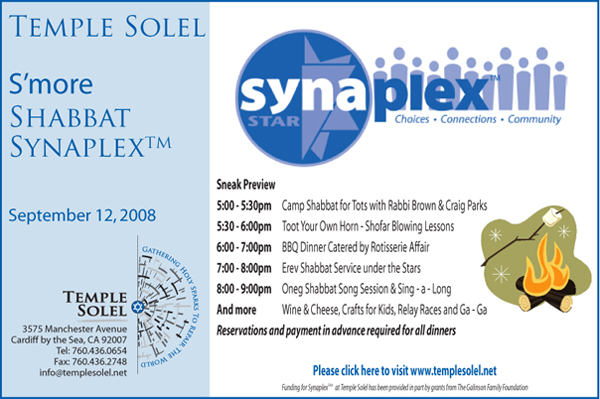
___________________________________________________________________
MON., SEPT. 29-THURS., OCT. 9


LETTER FROM JERUSALEM
U.S. should heed Israeli lesson in Lebanon
By Ira Sharkansky
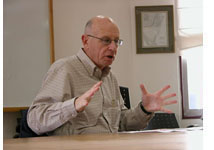 JERUSALEM—Barak Obama and John McCain are trapped by recent events to express themselves on Iraq and Afghanistan. JERUSALEM—Barak Obama and John McCain are trapped by recent events to express themselves on Iraq and Afghanistan.
We should not expect complete honesty from candidates. Humility can add to their stature among those who will read history years later. It may not help with the voters in November.
An unpleasant Israeli episode is relevant.
For several years leading up to the 1982 war, security and political figures developed what they thought were close working relations with counterparts among the Lebanese Christians. The background was Palestinian attacks against Israel from Lebanon, and the aggressiveness of armed Palestinians in the weak fabric of Lebanon.
Ariel Sharon was Defense Minister, with a long background in the military. When the invasion of Lebanon came in response to a Palestinian attack on the Israeli ambassador in London, Sharon thought he had a deal for Israeli and Christian cooperation against their mutual enemy.
The Christians sat on their hands until the Israelis were occupying Beirut. Then they sent their fighters into the Palestinian neighborhoods of Sabra and Shatilla, and massacred old men, women and children. This was not to help the Israelis, but to take revenge in the style of Lebanon for the killing of Bashir Gemayel, the Christian president-elect of Lebanon.
Largely as a result of this, 400,000 Israelis demonstrated in Tel Aviv against the government; Sharon lost his position as Defense Minister; and the Israeli military began a withdrawal after achieving only part of its mission.
What is the point?
Israeli figures with substantial backgrounds found themselves suckered by people they thought they knew well.
My own sense of being close to Lebanon comes from the day I was called to a brief stint of reserve duty. I ate an early breakfast in Jerusalem, drove to the border, crossed over in a military vehicle, did my job, had lunch, returned to the border and reached home in time for a late dinner.
Can we hope that Obama, McCain, and their many advisers will do better on the other side of the world than Israelis who thought they had the cooperation of neighbors?
I am pretty sure that Americans and Canadians understand one another. Also Americans and Western Europeans. Often they disagree about their national interests, but they are likely to understand one another.
Americans and Mexicans? Less so.
Americans, Iraqis and Afghans?
If I had a scheme for American action in Iraq or Afghanistan, it would come here.
What I read is the arrogance of people who call themselves experts.
A New York Times article about Obama's visit to Afghanistan noted that he met with a provincial governor with a "brutal past . . . (who) nevertheless (is) favored by the United States as someone who can get things done."
This figure may deserve the praise of Americans "for his tough action against poppy cultivation and official corruption," or he may have hoodwinked the foreigners. It is not easy to acquire the power of a war lord and regional leader without being involved in the principal national ventures of poppy growing and smuggling. The International Monetary Fund estimates that opium amounts to one-third of the national economy. Production reached record levels in 2007-08 despite programs of aid and eradication.
Obama is selling norms of openness and morality as part of his campaign in the United States. They have limited relevance for his aspiration of making policy about Afghanistan.
Part of the Israel lesson in Lebanon were the problems in learning the social map. Groups of Christians, Muslims, and Druze could be allies one day and fighting the next. Family is more important than political slogans, religion, or agreements. It is important to know who is related to who, and the history of bloody feuds that can return in a moment to end what seems to be an alliance.
Iraq and Afghanistan are also tribal societies, where national development is not what is described for Europe and North America in the textbooks of political science.
Neither of the American candidates can undo the most recent seven years. 9-11 really happened, along with the invasions and occupations of Iraq and Afghanistan. Victory is not likely in either of those countries. A presidential campaign is made for heroic promises rather than honest concessions about the limits of power.
Those of us who remember Vietnam know that a country that aspires to world leadership can leave a situation it helped to create, and overlook whatever occurs. The Americans hurt the Taliban badly, but did not defeat them. If they return to power, it will not be pretty. And without the Americans in Iraq, the Kurds, Sunnis, and Shiites are unlikely to live alongside one another peacefully.
Israeli leaders have become more modest in their plans for what should be done with respect to neighbors and enemies. There was no prolonged occupation of Lebanon in 2006, and there is great reluctance to invade Gaza. There is no occupation of the West Bank, but small unit incursions and departures.
The threat of nuclear weapons in the hands of Iranians who have spoken about Israel's destruction may produce something more dramatic. Those who relish dismal realism should read a scenario by an Israeli academic that includes escalation to the use of nuclear weapons.
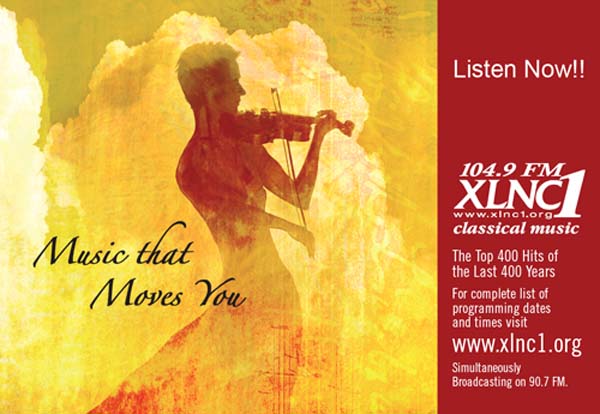

THE VIEW FROM JINSA
Some questions Obama should ask Abbas
By Shoshana Bryen
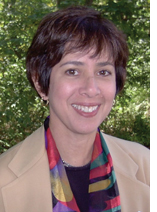 WASHINGTON, D.C—In January, President Bush visited the Palestinian Authority. We offered him some questions we thought might better acquaint him with Palestinian thinking on subjects of concern to the American people. In the spirit of bipartisanship, and because we didn't get answers from President Bush, we offer Senator Obama a similar set of questions he might ask Abu Mazen when he travels to the region: WASHINGTON, D.C—In January, President Bush visited the Palestinian Authority. We offered him some questions we thought might better acquaint him with Palestinian thinking on subjects of concern to the American people. In the spirit of bipartisanship, and because we didn't get answers from President Bush, we offer Senator Obama a similar set of questions he might ask Abu Mazen when he travels to the region:
- The Bush Administration has referred to "the occupation that began in 1967." What year did the Israeli "occupation of Palestine" actually begin?
- When Americans refer to "Israeli settlements," they mean houses for Jews built east of the 1949 Armistice Line. Would you show me where "Israeli settlements" actually are on your map? (Looking at the map, ask, "Where is Israel?")
- When Israelis are asked where they conceive the State of Palestine to be after a peace agreement, they respond with some variation of the West Bank and Gaza, with some arrangement for Jerusalem. This corresponds with State Department thinking about where Palestine will be. Where do you conceive the State of Israel to be after a peace agreement? (Sen. Obama, "In the sea" is not an acceptable answer here.)
- You are receiving American money, equipment and the help of an American Army General to improve your security force capabilities. How can you give the American people confidence that our military is not simply producing more capable Palestinians terrorists? How can you give the Israeli people confidence that you will use these capabilities to protect the people of Israel from Palestinian terrorism, since some of that terrorism has been conducted by your own Fatah forces?
- Gilad Shalit was captured while you were in control of Gaza. Why has he been denied visits from the International Red Cross? Will you join me in a demand that the Red Cross visit him?
- And, speaking of Gaza, it was under your control there that Qassam rockets began to be fired at Israel. Even during the temporary "cease fire," rocket and mortar fire has not ceased. If I am elected President, I will not tolerate fire from Canada or Mexico into the United States, even into sparsely populated parts of North Dakota or Arizona. Will you join me in a demand to end to the firing of rockets and mortars at Israel?
- Palestinians call the establishment of Israel in 1948 the "naqba," the catastrophe. Is the catastrophe the fact that a Jewish state was established in part of Mandatory Palestine, or that the Arabs did not permit the establishment of the corollary Palestinian Arab State? If the former, how do you think the United States can help you correct the injustice, and why do you think we would?
- May I make an unannounced visit to a classroom in the Palestinian Authority and take home samples of textbooks and lesson plans?
And one additional question:
- Ahmed Abdel Rahman, one of your advisers and a top Fatah official, welcomed the release of Samir Kuntar and Dalal Mughrabi. "This is an historic victory over Israeli arrogance," he said, describing Kuntar as a "big struggler" and Mughrabi as a "martyr who led one of the greatest freedom fighters' operations in the history of the Israeli-Palestinian conflict." He saluted "Hezbollah and its leaders and fighters." In the United States, these men are considered the vilest form of murderer - Kuntar smashed the skull of a little girl with his rifle, and Mughrabi "operation" killed a young American woman taking nature photographs and a group of bus drivers and their families on an outing. Why did you also send greetings to Kuntar on his release? Why is there a school named for Mughrabi in Hebron?


REFLECTIONS
The New York Times & 9th Commandment
By Sheila Orysiek
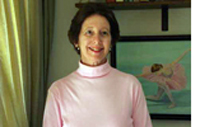 SAN DIEGO—The Ninth Commandment is a bit tricky. As I understand it, one shouldn’t falsely testify against another person, one shouldn’t lie, and one shouldn’t pretend to be something one is not. For instance, pretend that one is unbiased and open to all relevant opinions when in fact this isn’t true. When this is coupled with control of a major news organ - then free speech is in trouble. SAN DIEGO—The Ninth Commandment is a bit tricky. As I understand it, one shouldn’t falsely testify against another person, one shouldn’t lie, and one shouldn’t pretend to be something one is not. For instance, pretend that one is unbiased and open to all relevant opinions when in fact this isn’t true. When this is coupled with control of a major news organ - then free speech is in trouble.
Assume you are an editor of a major newspaper in a major city in a major country: like the op-ed editor of the New York Times in New York City, United States of America. There’s a war on, a presidential election looms, political conventions are just around the corner and the two presumptive nominees have real differences in opinion on how the war should be handled.
The office mail cart goes by and lo and behold, there on the desk in front of you is an envelope from one of the candidates - a lengthy op-ed submission for publication detailing the candidate’s positions and contrasting his positions with that of his opponent - especially concerning the war. Great day in the morning! A blessed editor indeed! Publish, publish, publish!
Then, about a week later - again you are diligently sitting and working in the office - nose to the grindstone….when a second letter arrives from the other candidate containing a submission describing his positions and contrasting them with his opponent. Another blessed day for an editor! The stuff of dreams!
Well, not so if you are David Shipley, op-ed editor of the New York Times. If you are he, you publish the first candidate - the presumptive candidate of the Democratic Party, Barack Obama, and you refuse to publish the second submission of the presumptive Republican candidate, John McCain
The reasons Shipley gives for the rejection which he sent as an e-mail are:
“I’d be very eager to publish the senator on the op-ed page. However, I’m not going to be able to accept this piece as currently written. I’d be pleased, though, to look at another draft. Let me suggest an approach."
“It would be terrific to have an article from Senator McCain that mirrors Senator Obama’s piece. To that end, the article would have to articulate, in concrete terms, how Senator McCain defines victory in Iraq. It would also have to lay out a clear plan for achieving victory — with troops levels, timetables and measures for compelling the Iraqis to cooperate. And it would need to describe the Senator’s Afghanistan strategy, spelling out how it meshes with his Iraq plan.”
Now, I am not an editor, but as I read it Shipley’s reply makes Obama’s op-ed piece the operating platform from which McCain is being forced to work - the word “mirror” being crucial. Why should McCain’s opinion have to mirror Obama’s?
Another even more crucial phrase is “troops levels, timetables” - which is precisely Obama’s position and one with which McCain disagrees and yet McCain is being forced by an op-ed editor to include “troops levels, timetables” on Obama’s terms.
Is it any accident that Shipley was a senior presidential speechwriter and special assistant to President Clinton from 1995 to 1997?
It seems to me that the task of an editor is one of guarding the standards of a publication - how submissions are written, how relevant they are and if they are of interest to the readership. On the news pages the editor is responsible for checking the accuracy of the information as well as the honesty of the writer/reporter. But, things change a bit on the op-ed page. That’s why it’s called “op-ed” - it’s not about accurate unbiased news. It’s precisely about the opinion of the writer on the news - or an issue in the news.
Shipley obviously is only interested in McCain’s opinion if it is shaped by Obama’s opinion with which he is in sympathy. This then is no longer an op-ed page, but the playpen for the editor. The New York Times has had a series in recent years of ethics problems, and while no one is faulting Shipley’s ethics - one can question his motives.
Is it any wonder why print media is losing readership?


THE JEWISH CITIZEN
Strom's klezmer hero helps save Pinsk
The Wedding That Saved A Town by Yale Strom, illustrations by Jenya Prosmitsky, Kar-Ben Publishing, 2008, ISBN 978-0-8225-7376-0; $7.95.
By Donald H. Harrison
 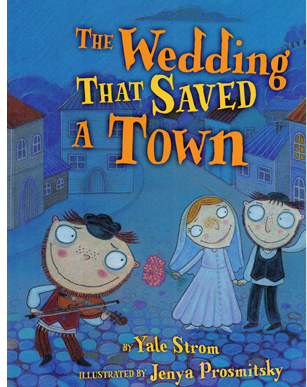 SAN DIEGO—Every time I turn around, San Diego's son, Yale Strom, is doing something else amazing. SAN DIEGO—Every time I turn around, San Diego's son, Yale Strom, is doing something else amazing.
We all know him as a klezmer musician, a documentary film maker about the Jews of Eastern Europe, the author of numerous books for adults, and as an artist in residence for the Jewish Studies program at San Diego State University. Yet, I was surprised when I opened a small shipment of children's books from Kar-Ben Publishing, and found among the books for review The Wedding That Saved A Town, written by Strom and illustrated by Jenya Prosmitsky.
So now Strom is a children's author too! I telephoned him at home and asked him to tell me the back story—how did he get the idea to write a story about a shvartze chaseneh—a "black wedding" held in a graveyard—in the superstition that if two orphans married each other in a grave yard, their dead parents would somehow intercede to stop a raging cholera epidemic?
He responded that when he was researching his various books on Eastern Europe, including The Book of Klezmer: The Music, The Folklore from the 14th Century to the 21st, he was in the town of Ropshitz, Poland, when some Jews told him the story of a wedding in a graveyard, saying it really happened. Strom said he believed the people when they said such a thing occurred, but considered it a bit far-fetched. Probably it was a tale that had been embroidered upon over time, so that it was more lore than fact, he decided.
Later, however, "I was doing some research for my book on klezmer, and I found an entry on Szunsk, (a town that) today is part of Ukraine, and sure enough they talk about this 'black wedding.' It may have happened in other places, but this one in Szunsk happened in the 1890s."
In retelling the happy-ending story for children, "I took some liberties," creating a klezmer musician character by name of Yiske, who took it upon himself to find an orphan groom for the would-be orphan bride Sheyndl-Rivke in the town of Pinsk. With his unusually perceptive horse, Fairdy (the Yiddish word for "horse"), he discusses a possible wedding with three prospective grooms. One wants to know if the bride is pretty, the second wants to know if she is rich. Each time, Fairdy whinnies in disgust.
The third orphan, Shmuel Sova, was a poor, honest, hard-working water carrier who was delighted for the opportunity to marry Sheyndl-Rivke, confessing that he always had admired her from afar but was too shy to ever speak to her. Fairdy whinnied in approval twice and kicked his hind legs!
And so the wedding was set, a canopy erected in the cemetery, with the rabbi officiating and the bride and groom performing the traditional rites. Thereafter, everyone enjoyed a klezmer performance by Yiske and his fellow klezmorim Itsik Indik, the flute player; Gimple Ganz, the trombone player, Motl Malpe, the drummer, and Hirshl Helfand, the bass player. A glossary in the back of the book helps non-Yiddish speakers learn that the band has a menagerie flavor: "Indik" means "turkey"; "ganz" is "goose"; "malpe" is "monkey;" and Helfand is "elephant."
Some other characters in the story are Reb Katz (Mr. Cat); Reb Leyb (Mr. Lion); Sruli Tsigel (Sruli Goat), and Rabbi Yamferd (Rabbi Walrus). Is it surprising that the lucky groom's name, Shmuel Sova, translates as Solomon the Owl (the wise)?
Recently, Strom read the tale to students in a mixture of grades at Garfield Elementary School. They were of African-American, Asian-American and Latino-American backgrounds, and knew little about Jewish culture. Strom interjected some klezmer music into the story-telling, and the children seemed entranced. Following the performance, he gave a copy of the book to each pupil. One student helper, an 8th grader who plays viola, came up to him afterwards and asked if he could please provide her with the score of some klezmer music. The new klezmer fan " was a Latina," Strom said.
Strom is hoping the book is successful enough that Kar-Ben will want him to create a series about Yiske the klezmer musician, who like Strom plays the violin. He said that he has several folk tales in mind that could teach about Eastern European Jewish culture, while introducing some more Yiddish words.
In the meantime, the remarkable Strom is working on another documentary, a short film, A Great Day on Eldridge Street about a gathering he arranged of klezmer musicians on New York City's Lower East Side.


DOING IT BETTER
Cane-raising at 60th college reunion
By Natasha Josefowitz, PhD
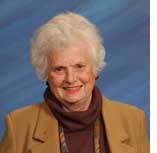 LA JOLLA, California—We more or less recognized each other, the name tags helped to jog our memories. We knew our ages—we are all 81 years old. Some of us look better than others: our former great athlete had a cane and complained of arthritis, the former pretty girl was overweight, but all-in-all we were aging well with our grey hair and wrinkles. Only one was still dying her hair and none of us had had facelifts. LA JOLLA, California—We more or less recognized each other, the name tags helped to jog our memories. We knew our ages—we are all 81 years old. Some of us look better than others: our former great athlete had a cane and complained of arthritis, the former pretty girl was overweight, but all-in-all we were aging well with our grey hair and wrinkles. Only one was still dying her hair and none of us had had facelifts.
Ours was the war years’ class, we were bused to USO dances, went out with V12 boys, and only the men deferred for medical reasons were seen on campus. Ours was also among the last classes that did not go to graduate school nor have careers. We waited for the men to come home from the front so we could get married and raise families. These were the expectations of our generation, and we dutifully fulfilled them. We volunteered in our communities, baked cookies, and raised these baby boomers whose children are now cluttering college admissions.
Back in 1948, Scripps College in Claremont, California, had 200 students and my class had thirty-three graduating women. There were four dorms and now there are twice that many with 900 students. I visited my old dorm room. I had, as I remembered, a lovely room with single occupancy. I looked into that room now with bunk beds and it had shrunk!
The two “date” rooms in the lobby were for visiting boys—the doors always open and a house mother looking in much too frequently—today they are dorm rooms. We dressed for dinner, had tea served in the afternoon and had to be in by 11:00 P.M. on weekdays and midnight on Saturdays or found the doors locked. We danced cheek to cheek and “necked” in the backseats of cars. Remember “necking knobs,” that knob on the steering wheel which allowed the boy’s right arm to encircle his girlfriend? Remember rumble seats and drive ins?
I did not recognize Claremont, which has grown more colleges with performing arts centers, libraries, science buildings, art galleries and coffee houses. We went to a senior art exhibit. It was all “installation art.” In other words, it was like the Museum of Contemporary Art in La Jolla—strange objects hanging from the ceiling or lying on the floor—evocative of something.
Our class dinner was fun—recounting, remembering, re-discovering, and mostly laughing a lot. We attended a class and listened to the awards given out to outstanding alumni—Scripps women are indeed a remarkable group of accomplished people having made a mark in the world. Only one in ten applicants is accepted, with many scholarships awarded to needy students. In my day we had no minorities and we were only four girls from foreign countries.
Today I saw multitudes of Latina, Asian and African-American girls wandering through the various campuses. This is a college town and young people were wearing flip-flops, shorts, and revealing tops with bra straps showing. How proper we used to be in comparison.
Nostalgia is bittersweet—where is that eighteen-year-old, freckled redhead with long braids that was madly in love with her biology professor, absorbing knowledge, and writing extensive class notes in a multitude of lined notebooks, which I admit I finally threw out only this year…and that was painful.
We had four required courses each year; it was the humanities program now called “Core.” It gave us a wonderful, well-rounded education.
And now I look forward to seeing hopefully most of my classmates for our 70th Reunion—ten years from now, we’ll all be 91 and probably with a few more canes.

ADVENTURES IN SAN DIEGO JEWISH HISTORY
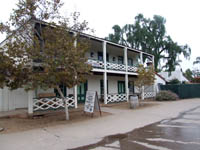
Robinson-Rose House
|
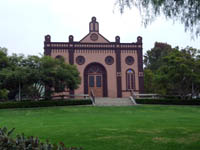
Old Temple Beth Israel |
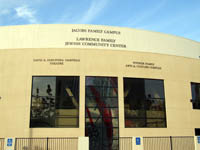
Lawrence Family JCC |
Editor's Note: We are reprinting news articles that appeared in back issues of various San Diego Jewish newspapers. You may access an index of the headlines of those articles by clicking here. You may also use the Google search program on our home page or on the headline index page to search for keywords or names.
Our Policy
From Southwestern Jewish Press, April 1949, page 6
This is the first issue of the Jewish Press in eighteen months. When we suspended publication in September of 1947, we were doubtful that we would publish another issue of the Press. But during that time hardly a day passed that we weren’t told how much the paper was being missed in the community, and asked when we were coming back into the field. So—after much consideration, we decided that on a once-a-month basis it is possible to produce a publication that is both financially feasible and would serve the needs of this growing community.
We do not think that it is necessary to state that we recognize the obligation a newspaper has to the people it serves. We point to our past performance. Aga9in we have subscribed to the finest National and International news services. The local scope is being covered by a number of writers.
In addition, it is the function of the Press to serve as an equalizer—a safety valve for those having gripes—beefs—or just wanting to air their own opinions…for anyone who feels that activities in the community are not what they would like them to be. Write a letter to the editor.
Our columns are open to all organizations for their publicity releases, as they have been in the past. We will continue to support the United Jewish Fund of San Diego throughout the year as well as during campaigns.
The many congratulatory messages and complimentary greetings from our non-Jewish friends have welcomed us back in the field in a most heart-warming manner. We appreciate these expressions of good will, and hope we have displayed their greetings attractively. When you patronize these merchants, tell them that you sw their ads in the Jewish Press.
Introducing Our Columnists
From Southwestern Jewish Press, April 1949, page 7
By Lewis Solomon and Ray Solomon
It is with a great deal of pleasure that we bring back to our readers Ida Nasatir and her column, “Looks at Books.” Ida has long been recognized as one of the leading Jewish women of this city, and her opinions are highly respected by all.
Lou Mogy, another “regular,” who has his fingers in every sport, is well qualified to keep you up to the minute on “sports around town.”
Jeannette (Radin) Learner will be remembered for her witty columns in the old Southwestern Jewish Review. A little poetry—a little prose—and a lot of fun. Jeanette will interview newcomers in her column, “Speaking of Peaking,” from time to time. If you know of any interesting new people, tell Jeannette.
Sig Stein is a comparatively recent arrival in San Diego (he’s already acclimated.) Stationed at the Marne Base before serving overseas as a combat officer, Sig, a Harvard graduate, thought enough of our fair city to send for his family and settle here. We feel certain that “On Short Order” will provoke thought.
Barbara Solomon, who formerly collaborated with Larry Solomon as the original “Copy Cats,” will now cover the activities of the young adult groups. A student at State College, Barbara will give us a breezy account of the activities of the “kampus kroud,” as well as other youth groups, in “Collegiates nd Intermejiates.” And not to forget the teenagers, we have asked Linda Solof to “cover” the comings and goings of the younger set. Linda attends Roosevelt Junior High, but we also report on the affairs of the “small fry” in “Linda’s Lookout.”
We can’t tell you much about red Borscht, our “under cover” man, except that we believe that you will find his “Nu?” very entertaining.
As for our social editor, Mrs. Ray (Pearl) Lieberman, she will report social events—weddings, anniversaries, births, bar-mitzvahs, parties and trips to L.A., etc.
We hope that you like the revived Jewish Press.
Leaders Herald Return of the Jewish Press
From Clinton D. McKinnon
Member of Congress
My thoughts naturally turn to my friends of the Jewish community on Passover. While I am proud to be your representative in Washington, it would give me much greater pleasure today to be in San Diego to personally extend my greetings.
May I also congratulate our good friend, Lewis Solomon, for bringing back to life the Jewish Press. Judging from past performance, he will make it an outstanding publication in community service and value. I wish him especial success.
*
From Harley E. Knox
Mayor, The City of San Diego
My hearty congratulations to the Southwestern Jewish Press. Your absence during the past year has been felt, and the community which you serve is happy to welcome you back again.
Best wishes for many years of continuing success.
From James Don Keller
District Attorney
I extend to you and to the Southwestern Jewish Press my sincere congratulations and every good wih upon the resumption of your publication.
The Press, as a medium of fair report and courier of topical information, has been greatly missed during the past year, and your return to active participation in our community affairs is welcome by all.
Through your good graces, may I at this time extend the warmest and most sincere season’s greetings to our Jewish friends.
*
From Peter H. Samson
The First Unitarian Church
My heartiest greetings to the Southwestern Jewish Press as it approaches the first issue of its new series! I extend these fraternal good wishes, not only on my own behalf personally, because of my deep respect and friendship for the humane ideals of San Diego Jewry, but also on behalf of my liberal congregation, which has long enjoyed the warmest of friendly relations with the Jewish congregations here, sharing with them in many a good cause having to do with human decency, tolerance and straight thinking. WE welcome the appearance of the Southwestern Jewish Press and feel that San Diego will be the better city for its influence.
With all good wishes personally and or your fine work, I remain, faithfully yours…
United Jewish Fund Campaign For $309,000 to Open This Week
From Southwestern Jewish Press, April 1949, page 7
Saul Chenkin and Louis Steinman, outstanding members of the San Diego Jewish community, will lead the 1949 combined United Jewish Appeal for $309,000, according to an announcement by the Board of Directors of the United Jewish Fund released by Eli H. Levenson, President. Chenkin and Steinman are planning an all out campaign with complete coverage of every Jewish person in the community and the outlying districts in the county. Plan of organization includes a gifts division, various trades and professions division, the women’s organization, young people’s division and a Christian campaign.
The women’s division will be headed by two of the outstanding women in the community, Mrs. Nathaniel Ratner, serving as chairman, and Mrs. Gabriel berg, President of Hadassah s co-chairman. A series of luncheons are being planned under the direction of the women’s division campaign advisory committee of Mrs. Saul Chenkin, last year’s chairman, now a member of the Board of Directors of the National Women’s Division, United Appeal, Mrs. Selma Getz, Mrs. Louis Steinman, and Mrs. A.P. Nasatir—1948’s co-chairmen.
Saul Chenkin has appointed the following leaders in the campaign to date: To head the men’s division set up, Murray Goodrich, Max Rabinowitz, Morris Douglas and Al Krasnow, co-chairmen. Lawrence Cantor of Cantor Brothers will again lead the auto accessories. Building trades will be led by Milo Berenson, Sid Goldhammer and John Ruskin; clothing by Its Penter, Sam Rassin and Mitlon Roberts; furniture by Victor Schulman and Ben Harris; groceries by Seymour Rabin; jewelry by Nathan Baranov and Sam Druskin; liquor by Harry Farb, Morris Feldman and Maurice Harris; professional by Carl Esenoff, Sol Price, Lew Weiss, Richard Levi and Dr. Robert Stone; locker club, tailors, cleaners by Abe Sklar, Eddie Kitaen and Ben Feinberg; surplus and salvage by Ed Bland. Other appointments will be made in the near future.
“1949 is a Year of Opportunity” in which we (will) be able to empty the DP Camps. It is a “Year of Exodus” according to the campaign co-chairmen, Saul Chenkin and Louis Steinman who made a joint statement in which they clarified the collar and cents aspect of the mammoth job to be done.
They pointed out that the irreducible minimum goal of the United Jewish Appeal for 1949 is $250,000,000. San Diego accepted a goal of $309,000 of which at least 75 percent will be used for the United Jewish Appeal and its three constituent agencies. The remainder will be allocated to the other 35 local, national and international organizations supported by the United Jewish Fund.
“This year the remaining 125,000 Jews must be moved out of the DPO Camps. Jews scattered through Rumania, Hungary, Poland, Czechoslovakia and Yugoslavia and Bulgaria must receive cash and food, relief and immigration where possible. One million Jews in North Africa and Moslem countries are existing under the most degrading conditions imaginable and must receive aid through the Joint Distribution Committee.
In Israel housing must be provided for 250,000 people who are expected in 1949. In the United States, the United Service for New Americans must be prepared to receive upwards of 25,000 Jewish refugees expected to immigrate here,” the chairmen emphasized.
United Jewish Fund headquarters are in Suite 301, 333 Plaza, San Diego.

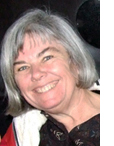 Nancy Harrison Nancy Harrison
cruise & tour specialist
(619) 265-0808



SAN DIEGO JEWISH WORLD THE WEEK IN REVIEW
USA
'Never Give In' is Arlen Specter's credo by Sheila Orysiek in San Diego
San Diego
San Diego, Tijuana to join in worldwide salute to Tel Aviv's 100th anniversary by Donald H. Harison in San Diego
Adventures in San Diego Jewish History
—August 7, 1947: Week at Palomar Closes Program
—August 7, 1947: Letter from Albert Hutler to Ray Solomon
—April 1949: Cavalcade To Trace Record of Lasker Lodge
—April 1949: J.W.B. Returns to San Diego
Middle East
Olmert's fingers on levers of power make those who would oust him quite cautious by Ira Sharkansky in Jerusalem
Judaism
Culture of death versus culture of life by Rabbi Leonard Rosenthal in San Diego
Stopping gossip—one hour at a time by Rabbi Baruch Lederman in San Diego
Adventures in San Diego Jewish History
—July 31, 1947: Pioneer Women
—July 31, 1947: Yo-Ma-Co
—August 7, 1947: Jewish Press to Suspend Publication: Decision Announced at Meeting of Representatives
—August 7, 1947: Announcement {Suspension of Publication}
—August 7, 1947: City-Wide Picnic at El Monte in Sept.
—August 7, 1947: Young Folks Zionist Group Formed
Arts
An errant yet charming father returns by Carol Davis in San Diego
Sports
A bissel sports trivia with Bruce Lowitt in Clearwater, Florida
Middle East
The heroes of Israel, from the Exodus hunger-strikers to Goldwasser and Regev by Judy Lash Balint in Jerusalem
San Diego
Making children smile, aiding world peace by Donald H. Harrison in San Diego
Arts
Nathan Detroit and friends trodding the boards at Moonlight Amphitheatre in Vista by Carol Davis in Vista, California
Chapter 17 of Reluctant Martyr, a serialized novel by Sheila Orysiek in San Diego
Adventures in San Diego Jewish History
—July 31, 1947: Lasker Lodge B.B.
—July 31, 1947: Jewish War Vets
—July 31, 1947: Jewish War Vets {Auxiliary}
—July 31, 1947: USO-JWB Activities
San Diego County Jewish Trivia: Balboa Park by Evelyn Kooperman in San Diego
Middle East
Bodies of Goldwasser and Regev return to Israel in post-Lebanon II war exchange by Ira Sharkansky in Jerusalem
Israel gives Hezbollah propaganda victory by Shoshana Bryen in Washington, D.C.
Arts
Questions propel play and Jewish director by Carol Davis in Solana Beach, California
Thursdays with the songs of Hal Wingard:
—#58, Dependency
—#60, Nurse!
—#324, Dear Mr. Spine
Adventures in San Diego Jewish History
—July 31, 1947: B’nai B’rith to Present Radios to Naval Hospital
—July 31, 1947:Camp Handicraft Exhibited at Reception
—July 31, 1947: 'CARE' offices move to new location
—July 31, 1947: Initial Meeting Accomplishes Much
Middle East
Palestinians depend on Israeli economy; yet Fayyed tries to weaken its prospects by Shoshana Bryen
Australia
A Roundup of Jewish news in Australia by Garry Fabian in Melbourne
—UN's one-sidedness condemned by Prof. Bayfsky
—Year-long saga finally laid to rest
—The end of a partnership
—Federal opposition shadow minister visits Israel
—Rabbi to officiate at first lesbian ceremony
—Community pays tribute to Rabbi Groner
—Charges imminent against Adelaide rabbi and wife
—Businessman launches Orthodox newspaper
—Kadimah Marks 10 Years
—It's Never too late to celebrate your Barmitzvah
—Another Jewish Boy hits the Big League
—By weight, rabbi warns of hazards of a kosher diet
Arts
Real life with 'Phantom' star Marni Raab by Carol Davis in San Diego
Sports
Watching All-Star game with friend Fox by Donald H. Harrison
Adventures in San Diego Jewish History
—July 24, 1947: JCRA
—July 31, 1947: Flash! {Camp Palomar}
—July 31, 1947: World Affairs Institute Here August 4th to 8th
—July 31, 1947: UJF Quota More Than Half Collected
)
Middle East
San Diego's UJF Mission arrives in Sha'ar Hanegev; where else to go for Latin food? by Ulla Hadar in Kibbutz Or Haner
Sarkozy sacrifices Franch honor to Syria by Shoshana Bryen in Washington, D.C.
Canada
Involving neo-Nazi youths in research led to turnaround in their attitudes by Rabbi Dow Marmur in Toronto
Arts
Jewish love for those great sailing ships by Donald H. Harrison in San Diego
Letters
When a community works in concert from David Amos in San Diego
G.I. Joe and biblical translation from Dan Schaffer in San Diego
Our growing arts and culture district from Alan Ziter in San Diego
Adventures in San Diego Jewish History
—July 24, 1947: Birdie Stodel B.B.
—July 24, 1947: Yo-Ma-Co
—July 24, 1947: Pioneer Women
—July 24, 1947: Temple Sisterhood Project Off To Fine Start
Link to previous editions
< BACK TO TOP
|
|


